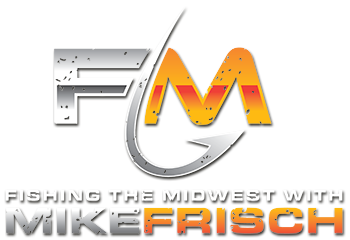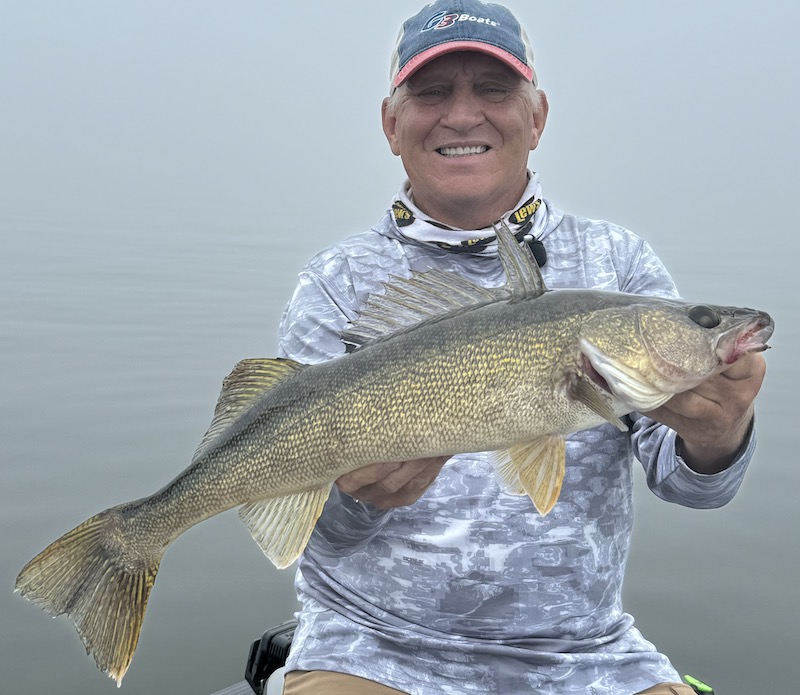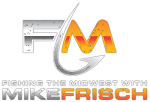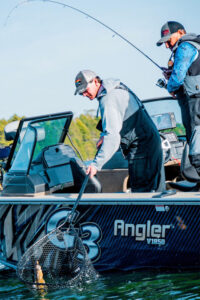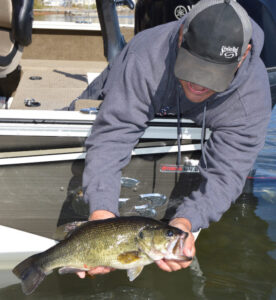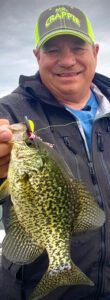By Mike Frisch and the Fishing the Midwest Team
A current rage in fishing revolves around Forward Facing Sonar (FFS) and it’s uses. Some anglers love this technology, while others despise it, saying it violates the rules of fair chase and going so far as to state that it could ruin fishing! In this writing, I am not going to debate that issue or present the “how tos” of FFS. In fact, this will be a bit “old school” as I am going to discuss a couple of fishing techniques that have been around for decades and still produce fish. I know that they still produce fish because we used them on TV shoots this summer to produce good fish catches!
The first old school fishing technique I will describe is what we call the plain rig walleye presentation. This rig consists of a bottom bouncer and plain fluorocarbon snell with 2 hooks tied in that are baited with a nightcrawler. We use this rig to target walleyes holding in lots of different places. We have used it the most to target classic walleye-holding structure like sunken humps, the edges of underwater islands, and weed edges. We have, however, caught fish pulling plain on the tops of flats and in featureless basins as well.
The plain rig works best when a heavy bottom bouncer (we use 2 ounces) is attached to a 15-to-20-pound braided line. As mentioned before, we use fluorocarbon line in 10-pound test and tie in two hooks using a snell knot. The hooks are about 2 ½ inches apart.
We pull plain about a mile an hour, simply slide the rod back to a biting fish, and sweep forward to hook the fish. A key with this rigging is to keep the line to the bottom bouncer nearly vertical but on bottom when pulling it as this imparts a fish attracting stutter to the bait.
“Plain” produces walleyes, while the venerable jig worm still produces bass. Called a shakey head or Ned rig by some, lots of old-time guides in the Midwest used a plastic worm on a jig-head years ago to catch bass during the summer. The only change was that old school jig worm anglers used worms in the 4-to-7-inch size range, while shakey heads and Ned rigs often use smaller baits. When filming TV, we often use Ned baits, but filmed a good segment last summer with 6-inch Filler Worms as our baits as well.
The Ned baits that have become favorites in our boats are the Ned Ocho and the Ned Cut-R Worm. Regardless which bait is selected, we rig them on the 1/8-ounce Tour Grade Ned Rig Head and fish them slowly on long casts. Often those casts are directed to deep weedlines that are home to lots of largemouth bass during summer. Several different colors of Ned baits will work. Our favorites have become those in the Dirt and Moon Juice color patterns. When smallmouth bass are the target, or when targeting largemouth spots where smallies are also found, we have had very good success using the Bama Craw color.
A great part about jig worm/Ned rig fishing is that a versatile 6’6” or 7-foot spinning rod and reel combination works great. In fact, I often use a 6’7” Lew’s Speed Stick that was designed with walleye jig fishing in mind for my jig worming. The new Lew’s Custom Lite SS spinning reel spooled with 15-pound Contra Braid works great for this fishing method and lots of other finesse methods as well. This reel has a shallow spool to reduce line capacity and eliminate line twist. It works great with braided line. A leader using 8- or 10-pound CONTRA fluorocarbon completes the set-up and makes for a low vis line presentation.
As always, enjoy your time on the water and remember to include a youngster in your next outdoors adventure!
Mike Frisch hosts the popular Fishing the Midwest TV show on Sportsman Channel, World Fishing Network, and Bally Sports. Visit www.fishingthemidwest.com to see more.
PHOTO – This author went old school with a plain rig to catch this walleye recently.
